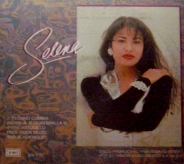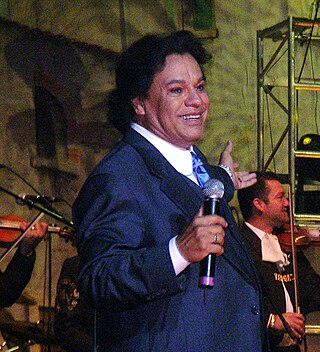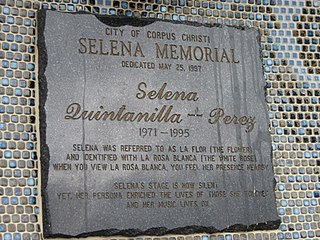
Selena Quintanilla-Pérez, known mononymously as Selena, was an American singer. Referred to as the "Queen of Tejano Music", her contributions to music and fashion made her one of the most celebrated Mexican-American entertainers of the late 20th century. In 2020, Billboard magazine put her in third place on their list of "Greatest Latino Artists of All Time", based on both Latin albums and Latin songs chart. Media outlets called her the "Tejano Madonna" for her clothing choices. She also ranks among the most influential Latin artists of all time and is credited for catapulting the Tejano genre into the mainstream market.
Latin American music has long influenced popular music in the United States. Within the industry, "Latin music" has influenced jazz, rhythm and blues, and country music, even giving rise to unique US styles of music, including salsa, New Mexico, Tejano, and Western. Fusion genres such as Chicano rock, Nuyorican rap, and Chicano rap have emerged from Latin communities within the United States.

Buena Vista Social Club is a studio album by Buena Vista Social Club, an ensemble of Cuban musicians directed by Juan de Marcos González and American guitarist Ry Cooder. Produced by Cooder, it was recorded at Havana's EGREM studios in March 1996 and released on September 16, 1997, through World Circuit internationally and Nonesuch Records in the United States. It is the only standard studio album exclusively credited to the Buena Vista Social Club.
Latin pop is a pop music subgenre that is a fusion of US–style music production with Latin music genres from anywhere in Latin America and Spain. Originating with Spanish-speaking musicians, Latin pop may also be made by musicians in Portuguese and the various Romance Creole languages. Latin pop usually combines upbeat Latin music with American pop music. Latin pop is commonly associated with Spanish-language pop, rock, and dance music.
Mexican pop is a music genre produced in Mexico, particularly intended for teenagers and young adults.
American singer Selena released eleven studio albums, three live albums, three boxsets, three remix albums, two soundtrack albums, and twenty compilation albums. Credited for elevating a music genre into the mainstream market, Selena remains the best-selling Tejano recording artist in history, selling over 18 million records worldwide. She was named the top-selling Latin artist of the 1990s decade in the US by Billboard magazine.

Anthology is the first box set by American singer Selena. It was released posthumously on April 7, 1998, through EMI Latin to commemorate the singer's works. The collection comprises 30 tracks, dispersed across three genre-themed discs: "Pop / English" showcases uptempo pop compositions, "Mariachi" highlights Mexican ballads featuring poignant narratives of heartache, and "Cumbia" presents danceable tropical rhythms. The album encompasses recordings from a 14-year-old Selena on her Alpha (1986) album to the posthumous "Disco Medley" (1997). With a limited number of unaltered tracks, Anthology predominantly features reworked and remastered musical arrangements, while preserving the singer's original vocals. Selena's death in March 1995 prompted an influx of requests from her admirers. The singer's father and manager, Abraham Quintanilla, expressed a desire to maintain his daughter's legacy through her music. However, Selena's family has faced criticism from both fans and the media, who accuse them of capitalizing on her death and commodifying her repertoire.

"Bidi Bidi Bom Bom" is a song recorded by American Tejano singer, Selena. It was released as the second single from her fourth studio album, Amor Prohibido (1994). Originally written about a cheerful fish swimming freely in the ocean, the song's title is an onomatopoeic phrase suggesting the palpitating heartbeat of a person lovestruck by the object of their affection. "Bidi Bidi Bom Bom" was written by Selena and her backup vocalist and dancer Pete Astudillo.

Mi Tierra is the third studio album by Cuban-American recording artist Gloria Estefan, released on June 22, 1993, by Epic Records. Produced by husband Emilio Estefan, it is a Spanish-language album and pays homage to her Cuban roots. The album features Cuban musical genres, including boleros, danzón and son music. Recorded at Crescent Moon Studios in Miami, Florida, Mi Tierra features notable Latin musicians such as Tito Puente, Arturo Sandoval, Cachao López, Chamin Correa and Paquito D'Rivera.

"Techno Cumbia" is a song recorded by American singer Selena for her fourth studio album, Amor Prohibido (1994). It was posthumously released as the b-side track to "Dreaming of You" through EMI Latin on August 14, 1995. Techno Cumbia would be put on her fifth and final studio album Dreaming of You (1995) and would be the fourth single for Dreaming Of You. "Techno Cumbia" was written by Pete Astudillo and co-written and produced by Selena's brother-producer A.B. Quintanilla. The song is a dance-pop and tecnocumbia recording with influences of dancehall, rap, Latin dance, and club music. Lyrically, Selena calls on people to dance her new style the "techno cumbia" and calls out those who cannot dance.
Top Latin Albums is a record chart published by Billboard magazine and is labeled as the most important music chart for Spanish language, full-length albums in the American music market. Like all Billboard album charts, the chart is based on sales. Nielsen SoundScan compiles the sales data from merchants representing more than 90 percent of the U.S. music retail market. The sample includes sales at music stores, the music departments of electronics and department stores, direct-to-consumer transactions, and Internet sales of physical albums or digital downloads. A limited array of verifiable sales from concert venues is also tabulated. To rank on this chart, an album must have 51% or more of its content recorded in Spanish. Listings of Top Latin Albums are also shown on Telemundo's music page through a partnership between the two companies.

The year-end charts for the Hot Latin Songs chart are published in the last issue of Billboard magazine every year. Initially, the chart was based on information provided by Nielsen Broadcast Data Systems, which collected airplay information from Latin radio stations in the United States. On the week ending October 20, 2012, the methodology was changed to track the best-performing Spanish-language songs based on digital downloads, streaming activity, and airplay from all radio stations in the country. The Year-End charts represent aggregated numbers from the weekly charts that were compiled for each artist, song and record company.
The 8th Lo Nuestro Awards ceremony, presented by Univision honoring the best Latin music of 1995 and 1996 took place on May 9, 1996, at a live presentation held at the James L. Knight Center in Miami, Florida. The ceremony was broadcast in the United States and Latin America by Univision.

Latin music is a term used by the music industry as a catch-all category for various styles of music from Ibero-America, which encompasses Latin America, Spain, Portugal, and the Latino population in Canada and the United States, as well as music that is sung in either Spanish and/or Portuguese.
This is a list of notable events in Latin music that took place in 1995.

Women have made significant contributions to Latin music, a genre which predates Italian explorer Christopher Columbus' arrival in Latin America in 1492 and the Spanish colonization of the Americas. The earliest musicians were Native Americans, hundreds of ethnic groups across the continent, whose lyrics "reflect conflict, beauty, pain, and loss that mark all human experience." Indigenous communities reserved music for women, who were given equal opportunities with men to teach, perform, sing, and dance. Ethnomusicologists have measured ceramic, animal-bone, and cane flutes from the Inca Empire which indicate a preference for women with a high vocal range. Women had equal social status, were trained, and received the same opportunities in music as men in indigenous communities until the arrival of Columbus in the late 15th century. European settlers brought patriarchal, machismo ideologies to the continent, replacing the idea of equality between men and women. They equated native music with "savagery" and European music with "civilization". Female musicians tended to be darker-skinned as a result of the slave trade, and contemporary society denigrated music as a profession. Latin music became Africanized, with syncopated rhythms and call-and-response; European settlement introduced harmony and the Spanish décima song form.

This article includes an overview of trends in Latin music in the 1990s, namely in Ibero-America. This includes the rise and fall of various subgenres in Latin music from 1990 to 1999.










